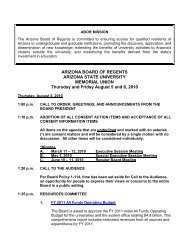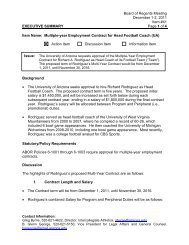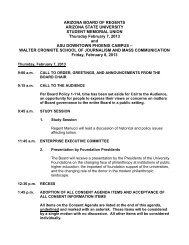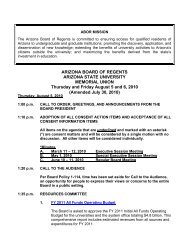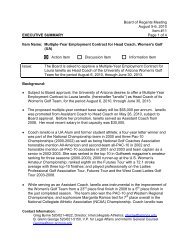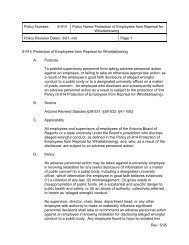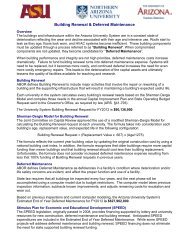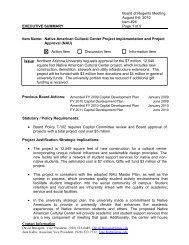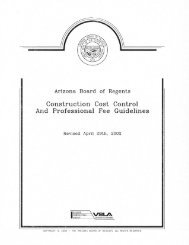Project Implementation Approval (PIA) - Arizona State University
Project Implementation Approval (PIA) - Arizona State University
Project Implementation Approval (PIA) - Arizona State University
You also want an ePaper? Increase the reach of your titles
YUMPU automatically turns print PDFs into web optimized ePapers that Google loves.
BUILDINGS, INFRASTRUCTURE AND LAND<br />
CAPITAL PLANNING AND DEVELOPMENT PROCESS<br />
and<br />
OWNERSHIP, MANAGEMENT AND USE OF<br />
UNIVERSITY REAL PROPERTY<br />
BASED ON<br />
ABOR POLICY CHAPTER VII<br />
AND APPLICABLE<br />
ARIZONA REVISED STATUTES<br />
August 2005<br />
<strong>Arizona</strong> Board of Regents<br />
2020 N. Central Ave., Suite 230<br />
Phoenix, AZ 85004-4593<br />
Telephone: (602) 229-2500 / Fax: (602) 229-2555
ABOR POLICY SUMMARY<br />
BUILDINGS, INFRASTRUCTURE AND LAND<br />
CAPITAL DEVELOPMENT PROCESS DIAGRAM<br />
Strategic Plan<br />
(5-year window)<br />
Process governed by<br />
ABOR Policies &<br />
<strong>Arizona</strong> <strong>State</strong> Statutes<br />
Master Plan<br />
(Land-use Plan)<br />
Building Renewal<br />
(Calculated per <strong>State</strong> formula)<br />
Capital Improvement Plan<br />
(Min. 3-year building plan)<br />
ABOR Capital<br />
<strong>Project</strong> Audits<br />
<strong>Project</strong> Closeout<br />
(Eval. Performance & Assess Costs)<br />
Capital Development Plan<br />
(1-year project go-to list)<br />
<strong>Project</strong> <strong>Implementation</strong> <strong>Approval</strong><br />
(<strong>Project</strong> defined w/ probable cost)<br />
<strong>Project</strong> Construction<br />
<strong>Project</strong> <strong>Approval</strong><br />
(Assured cost, ready to build)<br />
<strong>State</strong> JCCR Review<br />
August 2005 2 of 14
ABOR POLICY SUMMARY<br />
BUILDINGS, INFRASTRUCTURE AND LAND<br />
This document serves as a summary of the <strong>Arizona</strong> Board of Regents Policy Chapter VII –<br />
Buildings, Infrastructure and Land. This summary does not represent the entire ABOR Policy<br />
Chapter VII. A complete presentation of ABOR Policy can be found on the ABOR website<br />
under the Policy Manual section (www.abor.asu.edu/1_the_regents/policymanual/index.html).<br />
OVERVIEW<br />
A Capital <strong>Project</strong> is classified as the construction, renovation, or improvement of<br />
a university’s buildings, structures, facilities, infrastructure, and areas for the use<br />
or benefit of the <strong>Arizona</strong> Board of Regents, the universities under its jurisdiction,<br />
and the <strong>State</strong> of <strong>Arizona</strong>.<br />
New initiatives from the <strong>University</strong>’s Strategic Plan and Space Inventory and<br />
Utilization Report inform the need for new capital projects. New projects are<br />
located in accordance with the approved <strong>University</strong> Master Plan and are refined<br />
by the universities as they proceed through the Capital Improvement and Capital<br />
Development Planning process. Following the <strong>Project</strong> <strong>Implementation</strong> and<br />
<strong>Project</strong> <strong>Approval</strong> process, the project is built during the <strong>Project</strong> Construction and<br />
<strong>Project</strong> Closeout phases, and then maintained through the request and allocation<br />
of Building Renewal funds.<br />
The entire capital development process receives focused oversight by the Capital<br />
Committee. The Capital Committee is composed of four or more Regents<br />
charged to provide comprehensive review and approval of the capital<br />
development process, where delegated by Board policy, including capital<br />
projects, real property transactions, and financing activities.<br />
CAPITAL PROJECTS<br />
All capital projects with an estimated total project cost of $2 million or more<br />
are brought to the Regents for approval regardless of funding sources or<br />
financing structure. <strong>Project</strong>s that originally were not required to enter the<br />
capital development process, but subsequently are forecasted to exceed the<br />
dollar thresholds as described above, must be submitted for approval.<br />
The parameters of a project are not defined with the objective to bypass or<br />
minimize the requirements set forth in Board policy. The overall plans and<br />
costs for related and/or phased projects are also documented for<br />
consideration by the Board. <strong>Project</strong>s with common attributes, such as<br />
location, project type, etc., can be grouped together for Capital Development<br />
Plan and <strong>Project</strong> <strong>Implementation</strong> <strong>Approval</strong>. <strong>Project</strong>s within the group that<br />
exceed $2 million are required to return for <strong>Project</strong> <strong>Approval</strong>.<br />
The Board must approve any debt instrument regardless of total project cost,<br />
including lease-purchase agreements.<br />
August 2005 3 of 14
ABOR POLICY SUMMARY<br />
BUILDINGS, INFRASTRUCTURE AND LAND<br />
The universities are to maintain a Space Inventory and Utilization Report<br />
methodology that compares actual inventory and utilization data to the<br />
Regents' Space Guidelines, and assists in planning capital projects based<br />
upon space needs identified in the report. To assist in the budgeting of new<br />
projects, the universities are required to consider the Regent's Construction<br />
Cost Control and Professional Fee Guidelines and maintain a cost information<br />
database developed from completed projects.<br />
For each capital project, the universities must fully disclose the estimated<br />
costs of the project and the debt issuance, current debt capacity, debt<br />
service, the assumptions made for the debt repayment, and the fiscal impact<br />
of the project. The final maturity of any capital financing undertaken by a<br />
university will not exceed the estimated useful life of the capital asset being<br />
acquired or constructed.<br />
At the <strong>State</strong> government level, the Joint Committee on Capital Review<br />
(JCCR) reviews the scope, purpose, and estimated cost of university projects<br />
that require debt financing or lease-purchase agreements. Capital projects<br />
have JCCR review prior to requesting approval from the Board to issue<br />
bonds, and prior to construction.<br />
STRATEGIC PLANNING<br />
Each year the universities review and update their mission statements and<br />
five-year strategic plans, and the Board reviews the updated mission<br />
statements and strategic plans to ensure that they are consistent with systemwide<br />
goals and reflect current priorities.<br />
The strategic plans identify the major capital and operating implications of key<br />
strategies, and identify how new capital projects contribute to specific<br />
strategic objectives or satisfy other important criteria such as meeting life<br />
safety requirements or correcting existing deficiencies.<br />
MASTER PLANNING<br />
A Master Plan document sets forth the concepts and guiding principles for<br />
future land use and development of campus facilities and infrastructure to<br />
support the university’s mission statement and strategic plan for a ten- to<br />
twenty-year timeframe. Campus physical development plans are based on<br />
the academic and research services the institution intends to provide, on the<br />
student population it projects to serve, and on the image the university<br />
leadership wishes to project.<br />
The universities maintain an ongoing planning process and conduct<br />
comprehensive plan reviews and updates at approximately five-year intervals.<br />
Presentations of updated plans occur at the first of two Board meetings, with<br />
approval being granted at the second.<br />
August 2005 4 of 14
ABOR POLICY SUMMARY<br />
BUILDINGS, INFRASTRUCTURE AND LAND<br />
CAPITAL IMPROVEMENT PLAN (CIP)<br />
Capital Improvement Plans are a statutory requirement and serve as a<br />
reference document for current facilities inventory and related financial<br />
management information; as a general fund request; and to identify capital<br />
projects the university intends to implement during the next year, along with a<br />
forecast of proposed activities in the following two years.<br />
A Capital Improvement Plan includes the following elements:<br />
1. All Funds Summary<br />
2. Building Renewal Report<br />
3. Deferred Maintenance Report<br />
4. Building Inventory<br />
5. Lease Report<br />
6. Land Report<br />
7. Capital <strong>Project</strong> Status Report<br />
8. Two-Year Capital Plan plus a Two-Year Forecast<br />
9. <strong>Project</strong> Descriptions, Justifications, Scope and Budgets<br />
10. Debt Capacity<br />
<strong>State</strong> statute requires each university to inspect the condition, maintenance,<br />
and utilization of each building not less than once every four fiscal years and<br />
report its finding in the Capital Improvement Plan. In order to achieve this,<br />
each university inspects approximately 50 percent of its buildings within the<br />
first two years and inspects the remaining 50 percent in the remaining two<br />
years of the four-year cycle.<br />
CIP approval allows the university to proceed to the Capital Development<br />
Plan phase for the projects identified as first-year projects. Each university<br />
may expend up to 2 percent, not to exceed $250,000, of the estimated total<br />
project cost for advance planning and programming prior to placement of the<br />
project in the Capital Development Plan.<br />
CAPITAL DEVELOPMENT PLAN (CDP)<br />
The Capital Development Plan identifies the capital building projects that<br />
each university intends to initiate during the following fiscal year and is the<br />
initial Board approval of the concept, scope, and preliminary cost for each<br />
project. <strong>Project</strong>s included in the Capital Development Plan are generally<br />
carried forward from the previously approved annual Capital Improvement<br />
Plan.<br />
CDP approval authorizes the universities to hire outside consultants to begin<br />
the design, cost estimating, and/or alternative building delivery (i.e.,<br />
construction manager-at-risk, design/build) processes through schematic<br />
August 2005 5 of 14
ABOR POLICY SUMMARY<br />
BUILDINGS, INFRASTRUCTURE AND LAND<br />
design. No capital project can go forward if it is not identified in a Capital<br />
Development Plan.<br />
The Capital Development Plan may be considered for mid-year revisions<br />
including the addition of new projects, project budget adjustments, and<br />
deletion of projects. If a project fails to move forward in the applicable fiscal<br />
year, it must be resubmitted for inclusion in a subsequent Capital<br />
Development Plan.<br />
PROJECT IMPLEMENTATION APPROVAL (<strong>PIA</strong>)<br />
The <strong>Project</strong> <strong>Implementation</strong> <strong>Approval</strong> (<strong>PIA</strong>) request seeks the Board’s<br />
endorsement of the project’s scope, schedule, and budget. In preparation,<br />
the university will complete the project’s schematic design and may also<br />
contract for an alternative building delivery method such as Construction<br />
Manager at Risk (CM@R).<br />
In preparing for the <strong>Project</strong> <strong>Implementation</strong> <strong>Approval</strong> submittal, the<br />
universities are authorized to expend up to 3 percent of the estimated total<br />
project cost for professional and consultant services or $500,000 (whichever<br />
is greater), unless specifically authorized in the Capital Development Plan<br />
submittal.<br />
<strong>Project</strong> <strong>Implementation</strong> <strong>Approval</strong> allows the university to proceed to the<br />
<strong>Project</strong> <strong>Approval</strong> phase. <strong>Project</strong>s must be resubmitted to the Board if the<br />
estimated total project cost increases, if 15 percent or more of the net<br />
assignable square feet requires reassigning or changing, or if the project does<br />
not receive <strong>Project</strong> <strong>Approval</strong> within 24 months.<br />
PROJECT APPROVAL (PA)<br />
The <strong>Project</strong> <strong>Approval</strong> request seeks the Board’s approval to begin the <strong>Project</strong><br />
Construction phase based on a finished design, a complete set of<br />
construction documents, and a final cost estimate or Guaranteed Maximum<br />
Price.<br />
The university must seek Board approval if the project program has changed<br />
materially, the budget has increased, or the university does not initiate<br />
construction within 12 months of bid opening.<br />
CAPITAL COMMITTEE REVIEW PROCESS<br />
The Capital committee is charged with the focused review of all capital<br />
projects and has the delegated authority to grant <strong>Project</strong> <strong>Approval</strong> requests<br />
for projects with a total project cost between $2 million and $20 million.<br />
August 2005 6 of 14
ABOR POLICY SUMMARY<br />
BUILDINGS, INFRASTRUCTURE AND LAND<br />
<strong>Project</strong>s from $10 $2 million to to $10 $20 million<br />
<strong>PIA</strong> Reviewed by by the<br />
Capital Committee<br />
<strong>PIA</strong> Approved<br />
by by the the Board<br />
PA PA with no no changes:<br />
Approved by by Committee<br />
Committee Chair<br />
Reports to to the Board<br />
PA PA with with changes: changes: Reviewed Reviewed<br />
by by by Committee Committee<br />
PA PA with with changes: changes:<br />
Approved Approved by by by the the Board Board<br />
<strong>Project</strong>s over $20 million<br />
<strong>PIA</strong> Reviewed by the<br />
Capital Committee<br />
<strong>PIA</strong> Approved<br />
by the Board<br />
PA Reviewed by the<br />
Capital Committee<br />
PA Approved by<br />
the Board<br />
PROJECT CONSTRUCTION<br />
During the <strong>Project</strong> Construction phase, the university awards contracts and<br />
constructs the project in accordance with ABOR Policy 3-804, Design<br />
Services and Construction Services Procurement.<br />
The universities may transfer funds among expenditure categories in the total<br />
project budget without Board approval. Board approval is required for<br />
increases in total project cost.<br />
PROJECT CLOSEOUT<br />
During the <strong>Project</strong> Closeout phase, the university obtains substantial<br />
completion, completes building commissioning, final inspection, accepts and<br />
occupies the facility, and provides final payment to the consultants and<br />
contractors. The university performs a review and formal evaluation of the<br />
consultants' and contractors' performances.<br />
As a part of the Quarterly Report submittal, the Universities also transmit a<br />
Report for Substantially Completed <strong>Project</strong>s along with a copy of any relevant<br />
Certificates of Substantial Completion.<br />
REPORTS<br />
A quarterly Capital <strong>Project</strong> Status Report is submitted by the universities to<br />
keep the central office and Regents informed on the status of the capital<br />
assets at the universities.<br />
August 2005 7 of 14
ABOR POLICY SUMMARY<br />
BUILDINGS, INFRASTRUCTURE AND LAND<br />
The Space Inventory and Utilization Report compares the actual inventory of<br />
space and current utilization data to the Regents' Space Guidelines, and<br />
assists in planning capital projects based upon space needs identified in the<br />
report.<br />
AUDITING<br />
The central office audits capital projects on a periodic basis for compliance<br />
with Board policies. In addition, the central office audits a sample of projects<br />
funded with state-appropriated building renewal monies.<br />
TITLE OF REAL PROPERTY<br />
On behalf of the universities, the <strong>Arizona</strong> Board of Regents holds title to the<br />
universities’ properties and leases.<br />
PURCHASE OF REAL PROPERTY<br />
The purchase of real property by a university requires prior approval of the<br />
Board unless the property is located within the university planning boundary<br />
and the purchase price is less than $500,000.<br />
SALE OF REAL PROPERTY<br />
Real property that the university anticipates to be worth $250,000 or more<br />
may be sold only with prior authorization from the Board and requires a public<br />
auction. Real property anticipated to be worth less than $250,000 may be<br />
sold without Board approval by listing it with a licensed broker who is a<br />
member of any multiple listing service, or by public auction. No real property<br />
for which an appraisal is required may be sold for less than the lowest<br />
appraised value of the property.<br />
EXCHANGE OF REAL PROPERTY<br />
All exchanges of real property in which either parcel has a value of $250,000<br />
or more require Board approval. A university may enter into an exchange,<br />
notwithstanding a differential in the appraised values of the properties, if (a)<br />
the differential is paid in cash or other consideration acceptable to the<br />
university, or (b) the differential is less than 20 percent, and the university<br />
determines that the value given by the university is within the foreseeable<br />
range of possible outcomes if the property to be acquired by the university<br />
were to be taken under the power of eminent domain.<br />
August 2005 8 of 14
ABOR POLICY SUMMARY<br />
BUILDINGS, INFRASTRUCTURE AND LAND<br />
GRANTS/GIFTS OF REAL PROPERTY<br />
Each university may grant or amend easements/rights-of-way to other public<br />
entities and public service corporations or to private entities without prior<br />
Board approval. A university may accept gifts or bequests of real property.<br />
Prior to or concurrently with the acceptance, the university (a) examines the<br />
property to determine environmental and other liability risks associated with<br />
ownership, and (b) determines that the intention of the donor is documented<br />
in sufficient detail to provide the basis for the future managing or sale of the<br />
property.<br />
APPRAISALS<br />
One appraisal is obtained for any sale, purchase, or exchange of real<br />
property with an anticipated sale price of $100,000 or more but less than $1<br />
million. Two appraisals are obtained for any sale, purchase, or exchange of<br />
real property with an anticipated sale price of $1 million or more. All<br />
appraisals are to be independent, unilaterally requested, and paid for by the<br />
university. No appraisal is required in connection with a sale, purchase, or<br />
exchange of property with an anticipated sale price of less than $100,000. No<br />
appraisal may be used for any purchase, sale, or exchange unless the<br />
appraisal has been made within six months of the time of Board or university<br />
action approving the transaction.<br />
LEASES<br />
A university may enter into a lease or lease amendments as landlord or lessor<br />
without Board approval (except for use of athletic facilities by professional<br />
teams), provided all of the following criteria are met:<br />
a. The lease term including all renewals shall not exceed 120 months;<br />
b. The annual base lease amount does not exceed $500,000; and<br />
c. The rental rate meets or exceeds the fair rental value of the property.<br />
A university may enter into leases or lease amendments as tenant or lessee<br />
without Board approval provided all of the following criteria are met:<br />
a. The original lease term shall not exceed a total of 60 months;<br />
b. Renewal options in total shall not exceed an additional 60 months;<br />
c. The total annual rental including tax, insurance, and maintenance<br />
payable to, through, or on behalf of the landlord shall not exceed<br />
$500,000;<br />
d. The rental rate does not exceed fair rental value; and<br />
e. Funds are available.<br />
August 2005 9 of 14
ABOR POLICY SUMMARY<br />
BUILDINGS, INFRASTRUCTURE AND LAND<br />
Each university may authorize the use of university athletic facilities by<br />
professional teams meeting the standards approved by the Board. The rental<br />
rates for use of university facilities and properties by off-campus organizations<br />
are approved by the president of each institution.<br />
GLOSSARY<br />
Alternative Construction Delivery Methods: Building Delivery Processes that vary<br />
from the more standard Design-Bid-Build model. These may include<br />
Construction Manager-At-Risk and Design-Build.<br />
Backfill Plan: A plan for how release space will be reoccupied, including an<br />
estimate of associated costs and source of funds.<br />
Annual Capital Improvement Plan (CIP): Every year the universities are required<br />
to prepare a Capital Improvement Plan that contains proposals for spending<br />
on land acquisition, capital projects, energy systems, energy management<br />
systems and building renewal. This CIP is to include a one-year plan and at<br />
least a two-year forecast of proposed capital activity.<br />
Building Renewal: Major activities that involve the repair or reworking of a<br />
building and the supporting infrastructure that will result in maintaining a<br />
building's expected useful life. Building renewal does not include new<br />
building additions, new infrastructure additions, landscaping and area<br />
beautification, routine maintenance, or demolition and removal of a building.<br />
Capital Development Plan (CDP): A plan for identifying capital building projects<br />
that each university intends to initiate during the following fiscal year,<br />
including a fiscal management plan.<br />
Capital Committee: A committee composed of four or more regents charged to<br />
provide comprehensive review and approval of the capital development<br />
process, where delegated by Board policy, including capital projects, real<br />
property transactions, and financing activities.<br />
Capital <strong>Project</strong>s: Buildings, structures, facilities, infrastructure and areas<br />
constructed, renovated, or improved for the use or benefit of the <strong>Arizona</strong><br />
Board of Regents, the universities under its jurisdiction, and the <strong>State</strong> of<br />
<strong>Arizona</strong>. (Major capital projects are those projects with a total project cost of<br />
$2 million or greater.)<br />
Construction Documents: Those documents used for the solicitation of bids and<br />
the subsequent construction of a project. These include the bidding<br />
documents, contract forms, technical and general specifications, drawings,<br />
August 2005 10 of 14
ABOR POLICY SUMMARY<br />
BUILDINGS, INFRASTRUCTURE AND LAND<br />
any addenda issued during the bidding process and any approved change<br />
orders.<br />
Debt Ratio (ABOR): The numerator of the debt ratio shall include all capital debt<br />
payments for a fiscal year and the denominator shall be comprised of all<br />
unrestricted current expenditures and mandatory transfer.<br />
Deferred Maintenance: Facility condition deficiencies identified through physical<br />
inspections where deterioration and/or life safety concerns are evident and<br />
affect the proper functioning of the facility. Typical building components with<br />
deficiencies include: heating, ventilation and air conditioning, roofs, flooring,<br />
walls, ceiling and lighting, electrical and plumbing. Deferred maintenance<br />
does not include routine maintenance needs.<br />
Demolition: The removal of all or any part of a structure for any purpose.<br />
Fiscal Management Plan: A plan that identifies and justifies the source of funds,<br />
financing instruments, term and approaches (e.g., lease-lease/back), annual<br />
debt service, source of funds for debt service coverage, impact on tuition and<br />
annual operations and maintenance costs (including source of funds) for any<br />
capital project a university proposes to undertake. The plan will also address<br />
the potential impact of the project on university debt capacity and bonding<br />
authority (if applicable).<br />
Fixed Equipment: Consists of permanently affixed/installed furniture, fixtures and<br />
equipment. Examples include but are not limited to: elevators, bulletin<br />
boards, kitchen cabinets, environmental walk-in boxes, building directories,<br />
library shelving, drinking fountains, signage, plumbing fixtures, building<br />
mechanical systems, chalkboards, backbone telecom/data/systems and<br />
electrical systems, fume hoods, fixed electronic equipment, and fixed theater<br />
or classroom seating, as well as other fixtures and equipment installed with<br />
the intent of permanent use in that location.<br />
Furniture/Fixtures and Equipment (FF&E): Moveable furniture, fixtures, or<br />
equipment that requires no permanent connection to utilities or to the<br />
structure. They may require utility outlets, but are plug-in types. Examples<br />
include but are not limited to: moveable or non-fixed theater or classroom<br />
seating, electronic equipment, desks, chairs, bookcases, files, waste<br />
receptacles, easels, partitions, refrigerators, tables, credenzas, stools, typing<br />
stands, computer stands and other furniture, including interior wall/furniture<br />
systems. FF&E also includes scientific or technical equipment such as<br />
autoclaves, centrifuges, lasers, spectrometers, shop equipment/tools, kilns,<br />
and microscopes.<br />
Infrastructure: Non-building improvements that directly support operating a facility<br />
that is listed in the annual building system such as, but not limited to, utility<br />
August 2005 11 of 14
ABOR POLICY SUMMARY<br />
BUILDINGS, INFRASTRUCTURE AND LAND<br />
delivery systems, (e.g., steam and chilled water) roadway systems, external<br />
lighting systems, irrigation systems, sidewalks and parking lots. Additional<br />
campus infrastructure includes: campus grounds, other circulation systems<br />
(bike paths, pedestrian routes, etc.), and parking structures.<br />
Land acquisition: The procurement of real property by gift, grant, purchase,<br />
lease purchase, condemnation or other lawful means.<br />
Life Safety/Code Upgrades: Those items specifically related to compliance with<br />
life safety codes. Examples include but are not limited to: elimination of deadend<br />
corridors, improvement of building exits, installation of fire sprinklers in<br />
existing construction, eliminating hazardous conditions, etc.<br />
Major Maintenance: The periodic need to repair/rework building and<br />
infrastructure systems or components. Examples include but are not limited<br />
to: re-roofing, disassembling and rebuilding air-conditioning system water<br />
chillers and other long-term maintenance requirements.<br />
Master Plan: A document setting forth the concepts and guiding principles for<br />
future land use and development of campus facilities and infrastructure.<br />
New Construction: The creation of a new facility or the addition, expansion, or<br />
extension of an existing facility that adds to the building's overall gross square<br />
footage. Examples include but are not limited to: additions to existing<br />
facilities, construction of portable or temporary buildings, etc.<br />
Release Space: Space vacated in the existing inventory of campus buildings as a<br />
result of new space being added to that inventory (e.g., new construction,<br />
lease, etc.).<br />
Routine/Preventive Maintenance: The recurring need to keep in good repair<br />
building and infrastructure systems or components. Examples include but are<br />
not limited to: replacement of cooler pads, air filters, light bulbs, drive belts,<br />
lubrication, painting schedules, elevator maintenance, and other required<br />
scheduled maintenance.<br />
Shell Space: Building space that has not been finished as part of the original<br />
construction project. Examples include but are not limited to: unfinished<br />
areas of a building such as floors and basements.<br />
Total project cost: The full cost of a project that includes all direct construction<br />
costs (material, labor, site development, utilities, and infrastructure, extension,<br />
inflation adjustment, etc.) and indirect costs (land acquisition, architectural<br />
and engineering fees, furniture/fixtures & equipment, contingencies, etc.)<br />
August 2005 12 of 14
ABOR POLICY SUMMARY<br />
BUILDINGS, INFRASTRUCTURE AND LAND<br />
CAPITAL DEVELOPMENT PROCESS<br />
ANNUAL CALENDAR<br />
January<br />
CDP Updates/Revisions Presented to Board<br />
CIP Quarterly Report to Central Office – FY 2 nd Qtr.<br />
February<br />
March<br />
April<br />
May<br />
June<br />
July<br />
Annual Calendar issued by Central Office<br />
CIP Quarterly Report to Central Office – FY 3 rd Qtr.<br />
5/1 - Space Inventory & Utilization Report to Central Office<br />
CDP Draft to Central Office<br />
CDP Presented to the Board<br />
6/1 – Energy Conservation Report to Central Office<br />
CIP Quarterly Report to Central Office – FY 4 th Qtr.<br />
Private Lease Report to JCCR (every even numbered FY)<br />
August<br />
8/1 – <strong>University</strong> Building System Report to Central Office<br />
September<br />
CIP Draft Submitted to the Central Office<br />
CIP Presented to the Board<br />
Debt Capacity Report to the Central Office<br />
October<br />
10/15 - CIP Presented to Governor’s Office<br />
CIP Quarterly Report to Central Office – FY 1 st Qtr.<br />
November<br />
December<br />
August 2005 13 of 14
ABOR POLICY SUMMARY<br />
BUILDINGS, INFRASTRUCTURE AND LAND<br />
This page intentionally left blank<br />
August 2005 14 of 14



